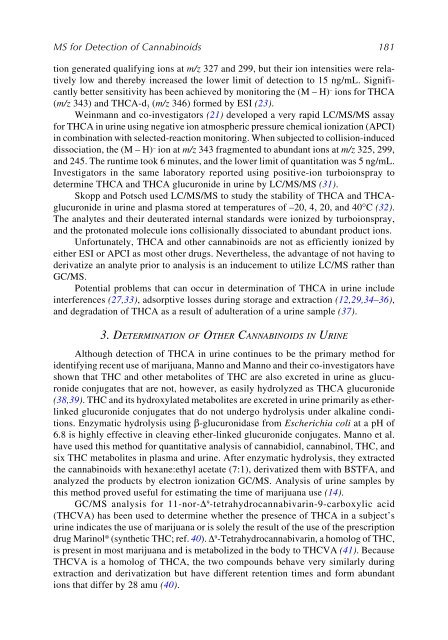Marijuana and the Cannabinoids
Marijuana and the Cannabinoids
Marijuana and the Cannabinoids
Create successful ePaper yourself
Turn your PDF publications into a flip-book with our unique Google optimized e-Paper software.
MS for Detection of <strong>Cannabinoids</strong> 181<br />
tion generated qualifying ions at m/z 327 <strong>and</strong> 299, but <strong>the</strong>ir ion intensities were relatively<br />
low <strong>and</strong> <strong>the</strong>reby increased <strong>the</strong> lower limit of detection to 15 ng/mL. Significantly<br />
better sensitivity has been achieved by monitoring <strong>the</strong> (M – H) – ions for THCA<br />
(m/z 343) <strong>and</strong> THCA-d 3 (m/z 346) formed by ESI (23).<br />
Weinmann <strong>and</strong> co-investigators (21) developed a very rapid LC/MS/MS assay<br />
for THCA in urine using negative ion atmospheric pressure chemical ionization (APCI)<br />
in combination with selected-reaction monitoring. When subjected to collision-induced<br />
dissociation, <strong>the</strong> (M – H) – ion at m/z 343 fragmented to abundant ions at m/z 325, 299,<br />
<strong>and</strong> 245. The runtime took 6 minutes, <strong>and</strong> <strong>the</strong> lower limit of quantitation was 5 ng/mL.<br />
Investigators in <strong>the</strong> same laboratory reported using positive-ion turboionspray to<br />
determine THCA <strong>and</strong> THCA glucuronide in urine by LC/MS/MS (31).<br />
Skopp <strong>and</strong> Potsch used LC/MS/MS to study <strong>the</strong> stability of THCA <strong>and</strong> THCAglucuronide<br />
in urine <strong>and</strong> plasma stored at temperatures of –20, 4, 20, <strong>and</strong> 40°C (32).<br />
The analytes <strong>and</strong> <strong>the</strong>ir deuterated internal st<strong>and</strong>ards were ionized by turboionspray,<br />
<strong>and</strong> <strong>the</strong> protonated molecule ions collisionally dissociated to abundant product ions.<br />
Unfortunately, THCA <strong>and</strong> o<strong>the</strong>r cannabinoids are not as efficiently ionized by<br />
ei<strong>the</strong>r ESI or APCI as most o<strong>the</strong>r drugs. Never<strong>the</strong>less, <strong>the</strong> advantage of not having to<br />
derivatize an analyte prior to analysis is an inducement to utilize LC/MS ra<strong>the</strong>r than<br />
GC/MS.<br />
Potential problems that can occur in determination of THCA in urine include<br />
interferences (27,33), adsorptive losses during storage <strong>and</strong> extraction (12,29,34–36),<br />
<strong>and</strong> degradation of THCA as a result of adulteration of a urine sample (37).<br />
3. DETERMINATION OF OTHER CANNABINOIDS IN URINE<br />
Although detection of THCA in urine continues to be <strong>the</strong> primary method for<br />
identifying recent use of marijuana, Manno <strong>and</strong> Manno <strong>and</strong> <strong>the</strong>ir co-investigators have<br />
shown that THC <strong>and</strong> o<strong>the</strong>r metabolites of THC are also excreted in urine as glucuronide<br />
conjugates that are not, however, as easily hydrolyzed as THCA glucuronide<br />
(38,39). THC <strong>and</strong> its hydroxylated metabolites are excreted in urine primarily as e<strong>the</strong>rlinked<br />
glucuronide conjugates that do not undergo hydrolysis under alkaline conditions.<br />
Enzymatic hydrolysis using β-glucuronidase from Escherichia coli at a pH of<br />
6.8 is highly effective in cleaving e<strong>the</strong>r-linked glucuronide conjugates. Manno et al.<br />
have used this method for quantitative analysis of cannabidiol, cannabinol, THC, <strong>and</strong><br />
six THC metabolites in plasma <strong>and</strong> urine. After enzymatic hydrolysis, <strong>the</strong>y extracted<br />
<strong>the</strong> cannabinoids with hexane:ethyl acetate (7:1), derivatized <strong>the</strong>m with BSTFA, <strong>and</strong><br />
analyzed <strong>the</strong> products by electron ionization GC/MS. Analysis of urine samples by<br />
this method proved useful for estimating <strong>the</strong> time of marijuana use (14).<br />
GC/MS analysis for 11-nor-∆ 9 -tetrahydrocannabivarin-9-carboxylic acid<br />
(THCVA) has been used to determine whe<strong>the</strong>r <strong>the</strong> presence of THCA in a subject’s<br />
urine indicates <strong>the</strong> use of marijuana or is solely <strong>the</strong> result of <strong>the</strong> use of <strong>the</strong> prescription<br />
drug Marinol ® (syn<strong>the</strong>tic THC; ref. 40). ∆ 9 -Tetrahydrocannabivarin, a homolog of THC,<br />
is present in most marijuana <strong>and</strong> is metabolized in <strong>the</strong> body to THCVA (41). Because<br />
THCVA is a homolog of THCA, <strong>the</strong> two compounds behave very similarly during<br />
extraction <strong>and</strong> derivatization but have different retention times <strong>and</strong> form abundant<br />
ions that differ by 28 amu (40).


